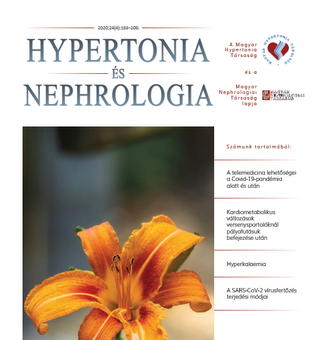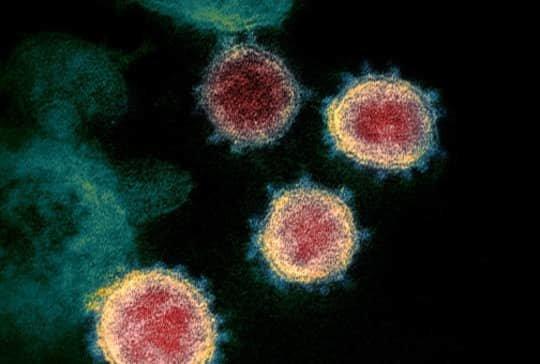The eLitMed.hu medical portal uses computer cookies for convenient operation. Detailed information can be found in the Cookie-policy.
Hypertension and nephrology - 2020;24(04)
Content
[Treatment and care of hypertensive patients during and after the Covid-19 pandemic. Possibilities and effectiveness of telemedicine]
[The course and outcome of an pandemic caused by coronaviruses are determined by many factors, such as the strength and dose of the infectious virus, the immune system of the affected individual, the underlying diseases, the speed of virus spread, age and environmental factors and methods of control. In old age, there is a significantly higher risk of developing severe cases and fatalities. The rate of loss of life is particularly high in social care and nursing homes. Hypertension as the underlying disease is the most common cause of death, but hypertension alone is not an independence risk factor, but the main reason is the co-morbidities and complications associated with viral infection. In the epidemic situation, the treatment and care of hypertensive patients poses special challenges for health and active primary and specialist care workers and, of course, for hypertonologists. The Hungarian Society of Hypertension expressed its opinions and recommendations to patients living at home and to doctors performing treatment and care during the Covid-19 virus epidemic and summarized the decision-making possibilities derived from the data obtained during the telemedicine consultation. We would like to present the details of the possibilities provided by telemedicine, the practical possibilities and advantages of the different methods of teleconsultation, and the models that can be implemented in a domestic environment. We have taken into account international experience to date, the new e-health strategy for chronic, non-communicable diseases and the WHO concept. Telemedicine, continuous teleconsultation ensures an optimal relationship between the patient and the doctor, increases the patient’s sense of security, improves drug adherence. The doctor receives reliable data about the patient’s condition and can send him instructions as well as information. The development of a harmonious balance between personal contact and telecommunications already shows the future, and the application of these methods must be developed in the epidemic-free period as well. Previous international (TASMINH-4, HOMED-BP etc.) and domestic (CONADPER-HU) studies have proved that telemonitoring of hypertensive patients can be successfully solved, improves patients’ drug adherence, increases the target blood pressure achievement rate and at the same time the patient will be the active part of the treatment. The method is especially useful in rural settlements without a doctor. Telemedicine monitoring of elderly and multimorbid patients is especially useful in social institutions and nursing homes. It is solved the continuous control of vital functions, ensures continuity of contact with the supervising physician and in urgent cases, allows for rapid intervention. Telemedicine is also of great importance due to the lack of human resources, as many things can be solved with such technology, there are no need so many personal encounters. In addition to influencing the course of this pandemic, it also plays an important role in efficiency, headcount, management and “convenience” in general practice and in all formes of medicine. The proposed models can not only be applied in an epidemic situation, but should continue to be part of everyday health work in future.]
[Association between cyclothymic affective temperament and hypertension]
[Affective temperaments (cyclothymic, hypertymic, depressive, anxious, irritable) are stable parts of personality and after adolescent only their minor changes are detectable. Their connections with psychopathology is well-described; depressive temperament plays role in major depression, cyclothymic temperament in bipolar II disorder, while hyperthymic temperament in bipolar I disorder. Moreover, scientific data of the last decade suggest, that affective temperaments are also associated with somatic diseases. Cyclothymic temperament is supposed to have the closest connection with hypertension. The prevalence of hypertension is higher parallel with the presence of dominant cyclothymic affective temperament and in this condition the frequency of cardiovascular complications in hypertensive patients was also described to be higher. In chronic hypertensive patients cyclothymic temperament score is positively associated with systolic blood pressure and in women with the earlier development of hypertension. The background of these associations is probably based on the more prevalent presence of common risk factors (smoking, obesity, alcoholism) with more pronounced cyclothymic temperament. The scientific importance of the research of the associations of personality traits including affective temperaments with somatic disorders can help in the identification of higher risk patient subgroups.]
[Post-career development of cardiometabolic changes and hypertension in competitive athletes]
[Regular physical activity is essential in delaying the aging processes (e.g. arterial remodelling – stiffening, metabolism, bodyweight), the beneficial effects of competitive sports – especially strength sports – according to the recent data of the literature are questionable. The beneficial effects of physical activity on the cardiovascular (CV) system are well known, however less is known regarding the delayed impacts of high intensity competitive sports on the CV system, especially after the sport career is over. This review summarizes the effects of active competitive sport and the post-career period on the cardiometabolic system with special attention to the systemic blood pressure and the development of metabolic syndrome. After sport career, the welldeveloped high performance cardiovascular- and metabolic system suddenly is much less used, but still supported by sport-level diet. It is well known that hypertension is a significant pathogenic factor in the development of cardiovascular diseases, characterized – among others – by reduced elasticity of large- and medium- sized vessels thereby importantly contributing to the development of systolic hypertension. Inflammation and thrombus formation both play an important role in the development of vascular injury and atherosclerosis. The increased tone of microvessels can impair the blood supply of certain organs, including the coronary circulation. It has been ample shown, that regular non-competitive, aerobic exercise activities are important factors in preventing hypertension. Such pathological changes become more evident after the development of post-career obesity, as well as the development of hypertension due to the activation of the renin-angiotensin system through sodium retention and other metabolic changes (increased glucose tolerance, insulin resistance, type II diabetes mellitus). It has been ample shown, that regular non-competitive, dynamic aerobic exercise activities are important factors in preventing hypertension. The frequency, intensity, type, and time (FITT) principle of exercise prescription is the first and common therapeutic approach, which represents the translation of cardiovascular basic science research results into hypertension treatment, thus can provide a personalized physical activity program/therapy according to medical needs not just for the post-career sportspersons, but the wide range of patients.]
[Non-pharmacological treatment of hypertension and reducing cardiovascular risk in general practitioners’ clusters]
[Hypertension and cardiovascular diseases are major public health issues. In their treatment non-pharmacological methods have a role in every case either alone or as a complement. Patient adherence is a key factor. The role of primary care is very important in the management and with general practitioners’ cluster model and with the involvement of new primary care professionals (for example: dietetitian, physiotherapist) the opportunities are expanding. In the A GP Cluster and in the Marosmenti GP Cluster the analysis of the patients’ results who participated in an individual health status examination, in dietetic and in physiotherapy services. Assessing the professionals’ attitudes towards GP cluster model. In the A GP Cluster 2409 people, in the Marosmenti GP Cluster 1826 people participated in an individual health status examination. 14.6% and 19.9% of the participants were under the age of 18. 58.9% and 60.7% of the participants over the age of 18 were female. 1083 and 232 patients used physiotherapy services, 147 and 187 people used dietetic services. The age distribution of the individual health status examinations is correspond to the Hungarian age pyramid. In addition to the preventive approach came into view the community based local health care services. The GP cluster model was welcomed by the patients, the physiotherapy was more popular than dietetic among them. All professionals of the GP clusters had a positive opinion of the professional work done in the project. Conclusion: There is a demand both from the patients and the healthcare professionals for the GP cluster concept. The establishing of an appropriate monitoring system and creating long-term, sustainable operating conditions are essential for achieving lasting social health gains. ]
[Hyperkalaemia IV.]
[The six-part summary presents the epidemiology, diagnosis, pathogenesis, and treatment of hyperkalaemia.]
[Routes of transmission of SARS-CoV-2 virus infection]
[The modes of transmission of SARS-CoV-2 virus have been analyzed in detail recently. It can be stated that the deposition of micro-sized virus particles on different surfaces and in the air is the main reason for the strength and spread of the epidemic all over the world. Spread of virus is present in practically every event of our lives and daily activities. The usual movements of human-human contact, the specific habits of our own lives (face smoothing, eye rubbing etc.) increase the spread. The greatest threat is posed by infected but asymptomatic individuals as carriers of the virus, and the main concern is the speed of transmission dynamics. We have strong evidence that 1.5-2 meter distance, mask wearing, and eye protection are crucial in reducing the rate of virus transmission. It can be assumed that, like normal influenza virus infections, the appearance of the coronavirus shows a seasonal appearance.]
1.
Clinical Neuroscience
[Headache registry in Szeged: Experiences regarding to migraine patients]2.
Clinical Neuroscience
[The new target population of stroke awareness campaign: Kindergarten students ]3.
Clinical Neuroscience
Is there any difference in mortality rates of atrial fibrillation detected before or after ischemic stroke?4.
Clinical Neuroscience
Factors influencing the level of stigma in Parkinson’s disease in western Turkey5.
Clinical Neuroscience
[The effects of demographic and clinical factors on the severity of poststroke aphasia]1.
2.
Clinical Oncology
[Pancreatic cancer: ESMO Clinical Practice Guideline for diagnosis, treatment and follow-up]3.
Clinical Oncology
[Pharmacovigilance landscape – Lessons from the past and opportunities for future]4.
5.






